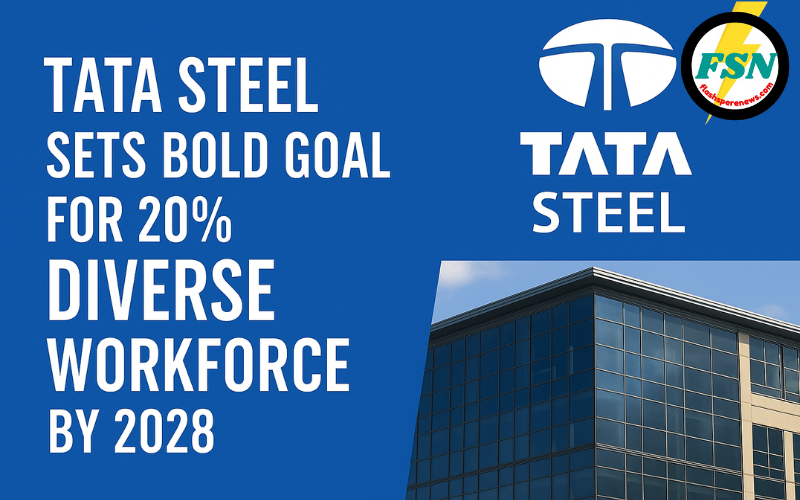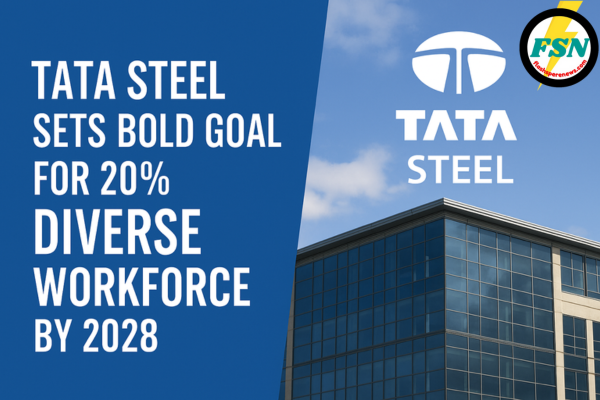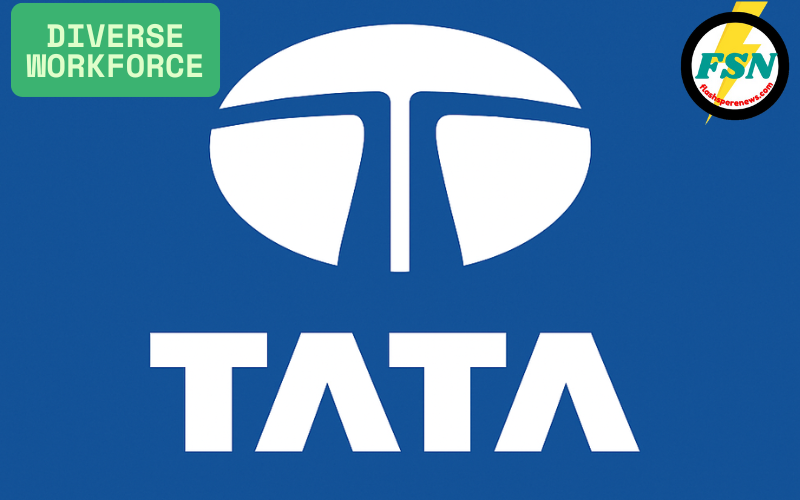Tata Steel Targets Bold Goal for 20% Diverse Workforce by 2028
Tata Steel Diverse Workforce, a leading name in the global steel industry, has recently announced its ambitious target to achieve a 20% diverse workforce by 2028. This forward-thinking initiative emphasizes the company’s commitment to inclusivity and progressive workplace policies. The announcement, which underscores Tata Steel’s values of sustainability and equal opportunity, marks a significant step towards fostering a more inclusive corporate environment.
Commitment to a Diverse Workforce
In today’s evolving corporate landscape, diversity has become more than just a buzzword; it’s a critical component of sustainable growth and innovation. Tata Steel’s vision for a diverse workforce is a testament to this ethos. By prioritizing diversity, the company aims to create a workplace that not only embraces varied perspectives but also drives excellence and creativity.
Diversity initiatives like this underscore Tata Steel’s broader goal of establishing itself as a leader in inclusivity within the industry. The focus keyword, “Diverse Workforce,” aligns perfectly with this initiative, symbolizing a significant shift and a remarkable move towards redefining workplace dynamics.
Current Workforce Composition
As it stands, Tata Steel’s workforce reflects a mosaic of talents, skills, and backgrounds. However, with women and other underrepresented groups accounting for a relatively smaller percentage, this new goal sets a bold benchmark. Achieving 20% diversity will require a multi-faceted approach, involving strategic recruitment, retention policies, and leadership development programs aimed at fostering inclusivity.
Tata Steel has consistently emphasized that diversity is not merely a metric to be achieved but a value to be upheld. The company’s leadership firmly believes that a diverse workforce leads to better decision-making, enhanced productivity, and a more robust corporate culture.
Strategies for Building a Diverse Workforce
To meet this ambitious goal, Tata Steel plans to implement several key strategies. These include targeted hiring campaigns, mentorship programs for underrepresented groups, and policies that promote work-life balance. Additionally, the company aims to establish support networks and resource groups to ensure that employees from diverse backgrounds feel valued and included.
The introduction of flexible working arrangements and robust anti-discrimination policies further highlights Tata Steel’s commitment to creating a safe and empowering workplace. By fostering a culture of inclusivity, the company is setting a precedent for others in the industry.
Expanding the Vision of a Diverse Workforce
Achieving a 20% diverse workforce by 2028 is not merely about numbers; it represents a holistic transformation in workplace culture. Tata Steel recognizes the need for ongoing education and awareness among its workforce to ensure that diversity is understood, embraced, and celebrated.
Workshops and training programs focused on unconscious bias, cultural competency, and effective communication are integral to this transformation. These initiatives aim to equip employees with the tools and knowledge needed to thrive in a diverse environment. Furthermore, Tata Steel’s leadership remains committed to creating opportunities for dialogue and collaboration, fostering a workplace where every voice is heard and valued.
Industry Impacts and Global Trends
Tata Steel’s diversity initiative is not an isolated effort. Across the globe, leading corporations are recognizing the value of diversity in driving innovation and growth. Studies have shown that companies with diverse leadership teams are more likely to outperform their peers, both financially and in terms of employee satisfaction.
The steel industry, traditionally dominated by homogeneous workforces, stands to benefit immensely from greater diversity. Tata Steel’s bold move sets a new standard for the sector, encouraging other companies to follow suit. This alignment with global trends not only enhances Tata Steel’s competitiveness but also strengthens its reputation as a forward-thinking organization.
Long-Term Benefits of a Diverse Workforce
A diverse workforce is a catalyst for creativity and innovation. By bringing together individuals with varied experiences, perspectives, and skills, Tata Steel can harness the collective power of its employees to address complex challenges and seize new opportunities.
Moreover, diversity fosters resilience. In a rapidly changing global landscape, companies that prioritize inclusivity are better equipped to adapt and thrive. Tata Steel’s commitment to diversity positions it as a leader in navigating the complexities of the modern business environment.
Building Inclusive Leadership
Leadership plays a crucial role in shaping workplace culture. Tata Steel’s diversity initiative includes a strong focus on developing inclusive leaders who can champion the company’s values and drive meaningful change. Through mentorship programs, leadership training, and succession planning, the company aims to build a pipeline of diverse talent equipped to lead the organization into the future.
Inclusive leadership is not just about representation; it’s about creating an environment where every employee feels empowered to contribute their best work. Tata Steel’s leaders are tasked with fostering a culture of trust, collaboration, and mutual respect, ensuring that diversity becomes a cornerstone of the company’s success.
Community Engagement and Social Impact
Tata Steel’s commitment to diversity extends beyond its own workforce. The company is actively engaged in community initiatives that promote education, skill development, and empowerment for underrepresented groups. By investing in local communities, Tata Steel is building a talent pipeline that reflects the diversity of the regions it operates in.
These efforts not only support the company’s workforce goals but also contribute to broader societal change. Tata Steel’s role as a corporate citizen underscores its dedication to creating a more equitable and inclusive world.

Measuring Progress and Ensuring Accountability
Transparency and accountability are key to the success of Tata Steel’s diversity initiative. The company has established robust mechanisms for tracking progress, including regular reporting and independent audits. Employee feedback is also a critical component, providing insights into what’s working and where improvements are needed.
By setting clear benchmarks and celebrating milestones, Tata Steel ensures that its diversity goals remain a top priority. This commitment to accountability not only drives internal progress but also inspires confidence among stakeholders, from employees to investors and the broader community.
The Future of Diversity at Tata Steel
As Tata Steel moves forward with its ambitious goal, the company remains steadfast in its belief that diversity is a journey, not a destination. By embedding inclusivity into its DNA, Tata Steel is paving the way for a brighter, more equitable future for its workforce and the industry as a whole.
The journey to achieving a 20% diverse workforce by 2028 is filled with challenges and opportunities. Tata Steel’s unwavering commitment to this vision reflects its determination to lead with purpose and integrity. Through collaboration, innovation, and a steadfast focus on its values, Tata Steel is set to redefine what it means to be a truly inclusive organization.
A Global Benchmark for Diversity and Inclusion
The bold goal set by Tata Steel is not just an internal milestone but a statement to the global business community. By integrating diversity into every facet of its operations, the company is contributing to a global shift towards inclusivity. This effort aligns with the United Nations’ Sustainable Development Goals (SDGs), particularly those focused on gender equality, reduced inequalities, and decent work for all.
The commitment to diversity also has significant economic implications. A McKinsey report highlights that companies in the top quartile for gender diversity on executive teams were 21% more likely to outperform on profitability. Such data underscores the tangible benefits of diversity and validates Tata Steel’s approach as both ethically sound and economically advantageous.
Empowering Employees Through Training and Development
At the core of Tata Steel’s strategy is the empowerment of its employees. Training and development programs are being designed to equip employees with the skills and knowledge needed to thrive in a diverse workplace. These initiatives focus on leadership, collaboration, and adaptability, ensuring that all employees can contribute effectively to the company’s goals.
Mentorship and sponsorship programs are also being introduced to provide support and guidance to employees from underrepresented groups. By fostering these relationships, Tata Steel aims to break down barriers and create pathways for career advancement.
Building a Culture of Belonging
Creating a diverse workforce is only the first step; fostering a culture of belonging is equally important. Tata Steel is committed to ensuring that every employee feels valued and included. This involves not only addressing systemic challenges but also celebrating the unique contributions of each individual.
Employee resource groups (ERGs) play a crucial role in this effort. These groups provide a platform for employees to connect, share experiences, and advocate for positive change. By supporting ERGs, Tata Steel is building a community where everyone has a voice and a sense of ownership.
Diversity as a Driver of Innovation
Innovation thrives in environments where diverse perspectives are valued. Tata Steel’s commitment to a diverse workforce is expected to fuel innovation across its operations. By bringing together individuals with different experiences and viewpoints, the company can develop creative solutions to complex challenges.
The focus on diversity also positions Tata Steel as an employer of choice for top talent. In a competitive job market, companies that prioritize inclusivity are more likely to attract and retain high-performing employees. This gives Tata Steel a strategic advantage in building a workforce that is both skilled and motivated.
Partnering with Stakeholders for Success Diverse Workforce
Achieving a diverse workforce requires collaboration with a wide range of stakeholders. Tata Steel is working closely with educational institutions, industry organizations, and government agencies to create opportunities for underrepresented groups. These partnerships are essential for building a talent pipeline that reflects the diversity of the communities the company serves.
Tata Steel’s suppliers and contractors are also being encouraged to adopt similar diversity initiatives. By extending its commitment beyond its own operations, the company is amplifying its impact and setting a new standard for the industry.
Inspiring the Next Generation
One of the most significant outcomes of Tata Steel’s diversity initiative is its potential to inspire the next generation. By demonstrating the value of inclusivity, the company is shaping perceptions and encouraging young professionals to pursue careers in traditionally underrepresented fields.
Outreach programs aimed at schools and universities are an integral part of this effort. These programs highlight the opportunities available in the steel industry and emphasize the importance of diversity in achieving long-term success.
In conclusion, Tata Steel’s bold Diverse Workforce goal to achieve a 20% diverse workforce by 2028 is a transformative step toward creating a workplace where everyone can thrive. By prioritizing diversity and inclusivity, the company is not only strengthening its own future but also setting a powerful example for others to follow. Through strategic initiatives, measurable milestones, and a relentless commitment to progress, Tata Steel is leading the charge for a more inclusive and equitable industry.


